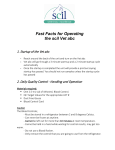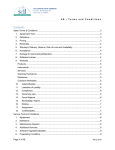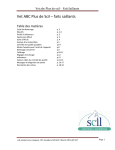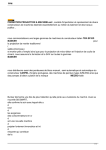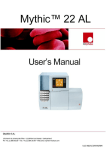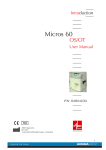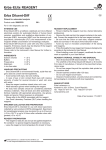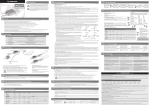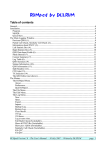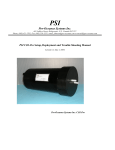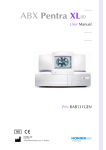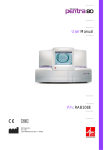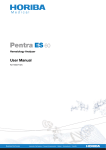Download SCIL Vet ABC Plus – Fast Facts
Transcript
Fast Facts for Operating the scil Vet abc Plus Hematology • Chemistry • Digital Radiography • Ultrasound • Orthopedics • Education SCIL Vet ABC Plus Fast Facts Table of Contents Start Up Cycle pg. 2 Reagents pg.2-3 Status Icon pg.3 Archive Settings pg.4 Quality Control Target Values pg.5-6 Quality Control handling pg.7 Running a Quality Control pg.8 Analyzing a Patient Sample pg.9 Machine Shutdown Procedure pg.10 Minimizing Reagent Usage pg.10 Concentrated Cleaning pg.11 Blockage Removal Procedure pg.12 Chamber Cleaning Procedure pg.13 Calibration pg.14-15 Flag Descriptions pg.16 Troubleshooting Status Messages pg. 17-18 ICON Descriptions pg. 19-23 Please Visit http://www.scilvet.ca/products/laboratory-diagnostics/productrange/51/product/95 for additional troubleshooting procedures and support SCIL Vet ABC Plus – Fast Facts Start Up Cycle A Start Up cycle is performed every time the machine is powered on by turning on the switch at the back of the machine. A temperature check cycle will initiate on power up and once it passes the Start up Cycle will begin. Samples should not be run until a Start Up has passed. To initiate a Start up Cycle Press the Status Button located at the top left of the screen and then press the Green Start Up Button corner of the screen. on the bottom right Installing the Reagent Pack 1. Remove the 4 red caps (3 on the bottom ports and 1 on the top waste port) 2. Firmly place the reagent pack into the right side of the Vet ABC Plus and connect the waste line to the top of the pack. ABC should be facing out. 3. Press the Maintenance Button 4. Press the Reagent Tab at the top of the screen 5. Press the Delete button to close the old Reagent 6. Press the Replace Button 7. Press the OK Button to confirm the reagent replacement 8. Press the Edit Button (notepad) 9. Press the Internal Keyboard Button 10. Enter the Lot number in the text field. The Lot number is located on the front of the reagent pack. (ex. 090706W3) If the Lot number is entered correctly the pack information will be loaded into the empty text fields 11. Press the OK Button. The pack should now be at 100% 12. 13. Press the Prime Button. Perform a Chamber Cleaning Procedure on page 13 2 CBC % Left in Pack 1. Press the Maintenance Button 2. Press the Reagent Tab 3. The percentage remaining is found on this screen Burp Reagent Pack Make sure that you Burp your pack regularly. Remove the waste line at the top of the reagent pack and press a pen or screw driver on the top port to release any build up of air inside the waste. The more the machine is used the more regularly you will have to burp the pack. Status Indicator The Status Indicator Button located in the top right of the screen has 3 states. GREEN - Indicates that the machine is functioning fine with no Alarms ORANGE - Indicates that an alarm has been raised You are still able to analyze a sample RED - Indicates that an alarm has been raised and the machine is locked You cannot analyze samples until the alarm is resolved. The 5 possible categories for Alarms in order as shown on the Status screen are; 1. 2. 3. 4. 5. Instrument Alarms QC Alarms Reagent Alarms Archive Alarms Application Alarms (Vet ABC Plus Icon) (QC Icon) (Drop Icon) (Archive Icon) (Disk Icon) 1 2 3 4 5 A message will be displayed explaining the reason for the Alarm. More information on these alarms can be found on pages 17/18 of this manual and in the SCIL Vet ABC Plus Short User Manual in Chapter 13. Ensure your start up has passed, your QC has passed and your Archives are up to date. This will help prevent and resolve most Status Alarms. 3 Archiving Settings The Status Icon will inform the user when an archive update is required. The SCIL Vet ABC Plus USB Key must be inserted in the front slot of the instrument. Generally the Reset Button can be used to reset all of the archive alarms except for the Analyses which is your past results. It is important to archive the past results. Access Archive Menu • • Press the Maintenance Button Press the Arch. Tab at the top of the screen. The category it does not require archiving You are required to create an archive Create an Archive or Reset Alarm Complete Export button will archive ALL of the results stored in your machine -Use this only if you have not archived your Results (Analyses) in over 30days Incremental Export button will archive the last 30 days -Use this to archive your Results (Analyses) if you have already done so within the last 30days Reset Alarm button will clear any Archive Alarms -Use this to clear any archive alarms other than the Analyses (Results) Archive Alarm if you want to save space on your USB Stick and save time. • Press the purple button beside any of the five alarms that have the beside them • Press either or or are resetting as explained above 4 depending on which alarm you Load Quality Control Target Values SCIL VET ABC PLUS Download QC Target Values to USB 1. Insert your Vet ABC Plus USB Key into a computer with Internet access. 2. VERY IMPORTANT – Before downloading a new QC Target Value file make sure you delete the old file on the USB stick named; “qctget_MXxxx ABC Plus Quality Control Values.csv” On the computer, the USB Stick is usually named “Removable Disk (E:)” 3. Using Internet Explorer, Go to http://www.scilvet.com, hover over service and click on downloads on the left to find the control file. There will be two files usually so you must make sure you identify the file that has the same expiry date as your Lot of Controls. 4. With your mouse, right click on the “Download” link beside “Control File Vet ABC Plus” and choose “Save Target As..” Do not use Google Chrome Web Browser, make sure you are using Internet Explorer. Save the File on the USB Stick normally named “Removable Disk (E:)”. 5. Left Click on the Green Arrow icon located in the bottom right corner of your computer screen and select “Safely Remove Hardware”, highlight the USB Key and click Stop. You can now remove your USB Key from the computer. DO NOT load all 3 sets of target values (low, normal, high) in all three columns on to the scil Vet ABC Plus+, unless you want to open and run all three control vials daily. Load the targets as you need them. After loading the QC values for a Vial DO NOT delete the values until the expiration date written on the Control Vial Box. You cannot enter a QC Lot # twice. If you need to you can rename your LOT # Upload QC Target Values to Vet ABC Plus 1. 2. Insert the USB Stick into the front slot of the instrument. Log on with any user profile 3. Press the QC Button. 4. Select the first column for Low (blue) or second for Normal (green) or third for High (red) in the QC screen by pressing the circle button at the top of the column. (Three columns can be used to run 3 control levels each day but normally only one vial is used for 16 days before opening and running another level.) 5. 6. Press the Control Importation Button Press the control level you want to load and have it highlighted yellow. Press the Control Importation Button again . Load only the control you plan on running. A control modification screen will appear. 5 7. 8. Press the Internal Keyboard Button. Press the “interQC time limit” at the top of the screen, highlight the text field and delete the default “24” and replace it will 9999. Press the Valid Button to accept the change. . Press the to close the Keyboard The QC targets are now loaded for the selected QC vial. The Status Indicator will flash orange and ask you to run a QC immediately. Refer to the Daily Quality Control Instruction to run the control. Deleting QC Target Values To delete the QC target values from the Vet ABC Plus; 1. Press the QC Button 2. Press the Circle Button at the top of the column that you want to 3. Press the Delete Button at the bottom to close the current control. 4. The column will now be empty and you can load a new set of Quality Control Target Values for the next control vial that will be used. You will be asked to archive the changes. The machine will ask the user to Archive the Quality Control Data. 5. Press the Maintenance Button Press the Archive Tab at the top of the screen. Press the Circle beside QC Press the Reset Alarm button 6 Daily Quality Control Handling Materials required: - One 2.5-mL vial of Minotrol, Blood Control. - QC Target Values loaded for the appropriate LOT # - Dust Free Gauze Caution The Blood Controls; - Must be stored in a refrigerator between 2 and 8 degrees Celsius. - Can never be frozen at anytime. - Cannot be left out for more than 10 minutes at room temperature. - Cannot be held in a hand while waiting for control results, may get too warm. - Do not use a Blood Rocker. - Only remove the control that you are going to use from the refrigerator. - Do not store controls in the refrigerator door Blood Control Preparation** - Read entire Quality Control Procedure in Fast Facts. - Remove ONE Blood Control Vial from the refrigerator. - Invert the vial back and forth slowly, paying attention to the concentration of cells at the bottom of the vial. There should not be a concentration of cells at the bottom of the vial when the vial is properly mixed. The bottom of the vial should be almost transparent when in the inverted position. DO NOT SHAKE - Once the control is properly mixed, roll the blood control vial in your hands until the vial is almost at room temperature. A good way to check the temperature is to press the vial to your cheek. - When running multiple Blood Controls, always invert the vial 10 times before each sample. Do not continue to roll the vial in your hands. TIPS If a control has been left out of the refrigerator too long the HGB value will be either too high or too low and usually accompanied by the exclamation flag ! If a control is dropped it may damage the cells and cause SCH, MIC flags as well as the $ Flag If dried flakes of blood have fallen inside the vial due to flaking around the rim and cap there is a chance that the * flag or the $ flag may appear beside the WBC or RBC measure value and could possibly create a low value due to a blockage. PLT counts are affected as well. Minotrol is stable until the printed expiration date if unopened. Once the control is opened it is good for 16 days in a refrigerator stored between 2 and 8 deg C as long as proper handling procedures have been followed. 7 Running a Quality Control 2. Run a Start Up Cycle and confirm that the Start up passed before running a blood control sample. 3. Press the Sample Identification Button. 4. Enter the lot number of the blood control you are going to run in the “Sample ID” field. (eg. MX075N) 5. Blood Control Preparation¹ as stated above. 6. Press the OK Button 7. A quality control information screen will appear and the needle will come down. Remove the cap and place the vial under the needle, press the sample bar to aspirate the sample. 8. Place the vial upright in a holder beside the machine until it is time to run another sample. 9. When the analysis of the sample is complete, the results will display on the screen. The machine will indicate if any values are out of range by assigning an “L” for LOW or an “H” for High beside the value(s) that is/are out of range. 10. If any of the values aren’t within range on the first sample, fax in your results and make sure you call Tech Support. 11. Or, if the results are not satisfactory and you suspect there could be a slight blockage perform a “Blockage Removal” followed by a Start Up Cycle before re running a Blood Control. Most problems are resolved by following this process. Make sure you put your control back in the refrigerator before starting this procedure. 12. If at anytime you feel you need assistance with any of the steps outlined or help with troubleshooting your Vet ABC Plus, please call Vet Novations technical support. Fax any failed or questionable results and start up cycle print outs to the fax number below. Technical Support Phone 1-866-382-6937 Technical Support Fax (705) 726-9202 8 Analyzing a Patient Sample Requirements • • • • Use EDTA K2 Lavender Top Tubes Ensure tubes are filled at least half way Mix sample thoroughly by inverting for 2 minutes Analyze the sample as soon as possible Procedure 1. 2. Log on as any user Press the Species Selection Button to change the species if necessary and 3. select the species you are going to analyze Press the Internal Keyboard Button and enter the Sample ID and any other fields you wish to input. An Auto ID is generated for the Sample ID. 4. 5. 6. 7. Press the OK Button When the needle comes down place the sample tube under the needle and press the sample bar to aspirate the sample Once the analysis is complete the measured results and histograms will appear on the screen. If you notice any flags or alarms and are unsure of what they mean, please consult the Flags and Limits section of the Fast Facts Manual. You can also consult your SCIL Vet ABC Plus users manual for more detailed explanations. Sample ID is the only field that must be filled in to run a sample. AUTOSID is default. Animal ID the patient will be saved internally and can be identified by this. Date of Birth if you use this field, you must enter all fields (Month, Day, Year) 9 Machine Shutdown Procedure It is very important to follow the shut down procedure for your Vet ABC Plus. 1. Press the Exit Button located at the bottom left of your screen 2. 3. Press the Logout Button Power the machine off by flicking the switch located at the back of the machine to the right of the power cable. Other Buttons Reset Button will reboot the instrument without switching off the power. Logout Button will end a session and return to the log in screen ALWAYS cover the Vet ABC Plus after it is shut down with the provided Dust Cover Minimize Reagent Consumption 1. Never turn the Vet ABC+ on unless you need to use it. 2. Once the analyzer has been turned on, leave it on until the end of the day 3. Never press the Shut Down Button 4. If your blood control does not pass call Vet Novations Tech support. Do not continue running controls until Tech support has advised you to. 5. Perform a blockage removal procedure instead of running a concentrated cleaning when results indicate that a cleaning is required. The blockage removal procedure does not require any reagents. (Pg. 10) 6. Maintain your Vet ABC+ by performing one concentrated cleaning a week and one Chamber Cleaning Procedure per Reagent Pack change to reduce crystallization in the chambers. 10 Concentrated Cleaning A maximum of one per week is required. 1. Press the Maintenance Button 2. Press the Customer Service Button 3. Press the Circle located beside Concentrated Cleaning 4. Press the Start Cycle Button 5. Press the OK Button to proceed 6. Follow the instructions on the screen. WBC is on the left RBC is on the right. Minoclair is 50/50 Javex/Distilled water for a total of 6 mL. 7. Use your Key to open the front door. Close the front door once you have finished following the instructions. 8. Press the OK Button minutes to complete. to begin the process. The process will take 10 11 Blockage Removal Procedure This procedure will use no reagents from your pack and can be used to resolve blockages (Low WBC or Low RBC) , constant flags (* and $) and Start Up Failures. 1. Log in as ADMIN (Password:SCIL) 2. Select the Maintenance menu 3. Select Serv. Tab at the top 4. Select Customer Service Menu 5. Select Chambers Draining and Press Start Cycle Icon 6. Open Front Door 7. Put 3mL of 50/50 Bleach/Distilled water mixture in each of the chambers 8. Close door 9. Select Backflush and Press the Start Cycle Icon to run the Backflush 10. Repeat the Backflush 10 times 11. Select Drain Chambers and Press the Start Cycle Icon 12. Press the Status Icon at the top right of the screen 13. Press the Start Up Button 12 Chamber Cleaning Procedure This procedure should be done when changing the reagent pack 1. Log in as VET and press the Maintenance Button 2. Select the Service sub menu at the top left of the screen 3. Press the Customer Service Button 4. Press the purple button beside Chambers Draining 5. Press the Start Cycle Button 6. Open up the Front Door of the Vet ABC Plus 7. Use the Vet ABC 2.5mm Allen Key screw driver to loosen the one screw holding the black cover on. Once the screw is loosened about 3 turns the cover will lift up. Pull the cover towards you to remove it. 8. Use a dampened KimWipe with distilled water to clean around the rim of each chamber. Be VERY CAREFUL not to allow any of the crystallized flakes to land inside the chambers 9. Put 3mL of distilled water in each of the chambers and start the Chambers Draining cycle again 10. Slide the black cover back on making sure the cover sits flush against the frame and no tubes are pinched. Run a concentrated cleaning once you have finished. 13 Calibration The SCIL Vet ABC Plus should be calibrated every six months. Before Calibrating • • • • Perform a Blockage Removal and run a Start Up Check your photometer reading and adjust if necessary. Go to http://www.scilvet.com/ca/Service/Download and search for Photometer Adjustment for the Vet ABC Plus Run 1 Daily Quality Control and make sure the values aren’t too far out of range. Slightly out of range is acceptable If you are unsure of your results please call technical support before proceeding with the calibration. DO NOT remove the Calibration Fluid from the refrigerator until step 6 is complete and you understand the instructions. Do not follow the instructions that come with the calibrator. Only follow these instructions to complete the calibration. When calibrating your machine the measured value of each parameter may not reflect the target values indicated on the sheet provided with the calibrator vial. Your goal is not to recreate the values on the target sheet provided with the calibrator vial; the targets are used as reference for calibrating the instrument. If you are in the middle of doing a calibration and need to call technical support make sure you return your calibration fluid to the refrigerator. 1. 2. Press the Quality Control (QC) Menu Button Press the Cal. Tab at the top of the screen 3. Press the Calibration Creation Button 4. Press the Internal Keyboard Button and fill in all required data. This information comes with your calibrator vial on the sheet provided. • Set the number of cycles to 6. • Enter the expiry date of the calibrator vial and the CX LOT # • Enter the target values as shown on the calibrator vial sheet • 5. Press the Exit Button when all data has been input. Remove your calibrator vial from the refrigerator and follow the Blood Preparation instructions found in the Daily Quality Control instructions 14 6. 7. Press the OK Button the calibration cycle will begin. The needle will come down. Aspirate the sample by placing the vial under the needle and press the sample bar. 8. 9. Results will be displayed. Press the OK Button to accept the results You can press the Cancel Button to discard a run and re run the sample if you feel that the results are not satisfactory. If during any Run, the results are displayed and there is no OK Button, the machine won’t accept that run due to a flag on one of the parameters. Press the Cancel Button to proceed. You will have to re run the sample by pressing the sample bar again. If your calibration fails, return your calibrator vial to the refrigerator immediately. Keep your print out and all related information and call Vet Novations technical support line for further instructions. You can also fax your print out to the Vet Novations technical support fax line. Technical Support Phone 1-866-382-6937 Technical Support Fax (705) 726-9202 15 Flag Descriptions * - following either WBC, RBC HCT or PLT -- system analyzed the sample 3 times but all 3 counts differed and were outside the system’s precision limits (see below). Result should be verified by repeating the sample. $ - between the test result and the units -- 3 counts were made and 2 were within the system’s precision limits (see below). The result can be accepted. ! - next to the HGB result -- the difference between HGB blank done for this analysis and the HGB blank done for the previous analysis was outside the system’s precision limits. Instrument provides a result based on the previous HGB blank. Result can be accepted. If flag persists for more than 3 consecutive times call Vet Novations or See Section 7, 5. Troubleshooting, page 7-25 of the Vet ABC Plus Manual H / L – behind result: Result is higher / lower than the reference value. ---D or < printed instead of a result -- linearity range for that parameter has been exceeded (see below). Repeat using a 1:2 dilution with saline solution. Multiply your results by 3. MIC following PLT Flags -- microcytes present in the platelet measurement zone. Verify result with manual count. SCH following PLT Flags -- schistocytes or platelet aggregates present in the platelet measuring zone. Review slide before reporting results. SCL following PLT Flags -- small particles in the 2 - 3 fl zone. Reanalyze sample. If flag persists, perform an automatic cleaning cycle and repeat again. If flag still persists, perform manual platelet count. AG1 and AG2 – Flags for big Leucocytes aggregates (> 1,5 % / 2,5 % of total Leucocytes). Mix sample properly and repeat measurement. 16 Troubleshooting Status Messages Instrument Status Button 1. Start Up Cycle Failed - Make sure there is fluid left in the reagent packs port 2 and 3 - Re run Startup - Run concentrated cleaning and re run start up 2. Invalid Start Up Cycle - Initiate the Start up Cycle 3. Cycle Cancelled by User - Initiate Start Up Cycle 4. Critical Cycle Error - Check information in Maintenance/Logs/Errors. Press Print button. - Fax print out to Vet Novations. 5. Reagent Temperature Error - If the clinic is below 18deg Celsius in the morning this may trigger the alarm - If the machine is placed near a window this may trigger the alarm. - Restart unit to clear error - This error has no effect on sample results. QC Status Button 1. Inter QC time limit - QC target values have been loaded but a Blood Control has not been run yet. - Run the corresponding blood control. 2. Invalid QC Lot Number - Cannot use Lot # more than once. - Edit the Lot # loaded in the QC menu by selecting the Edit/Keyboard buttons 3. XB Drift - Run QC and call Vet Novations Technical Support - Can be caused if default species limits have been changed 17 Reagent Status Button 1. Reagent Empty - Pack is empty and needs to be replaced - A pack was replaced but the user forgot to reset the reagent count. 2. Reagent Pack Expired - Verify the expiry date, replace reagent pack. 3. Low Reagent Level PACK - Reagent is getting low, pack needs to be replaced soon - Monitor the % of reagent remaining or replace pack to be safe. Archive Status Button Path: Maintenance/Arch 1. Settings Archive should be Archived - Log in as ADMIN (pw:SCIL) and archive Settings - When any machine changes are made by user, Settings must be archived 2. Analyzer Archive should be Archived - Log in as ADMIN (pw:SCIL) and archive Analyzer Settings 3. Logs Archive should be Archived - Logs must be archived once a month 4. QC Archive should be Archived - When a control is closed you must archive the QC 5. Analyse Archive should be Archived - Archive Analyse when prompted or once a week to back up data. Application Status Button 1. LIS Connection Failed - There is a problem with transferring data to a computer - User accidentally pressed the “Send button” 2. Printer Error - Make sure printer is turned on, plugged in, has paper or toner. 18 ICON Descriptions MENU Sample ID – Enter data for running a sample Quality Control – (Quality control data, calibration) Results Archive – Stored and searchable results up to 1000 results Maintenance – (Reagents, archive, stats, logs, service) Status – Displays all alarms, run a Start Up from this screen Exit – Change user, restart or shut down machine Help – Provides help with the current screen 19 ACTION Start up – Initiates a Start Up Cycle Shutdown – Shuts machine down (DO NOT USE) Restart – Restarts machine Logout – Disconnects current user and displays the Log In screen Edit – Allows user to begin making changes within the current screen OK – Validates an action Cancel – Cancels an action Reset – Resets the entered fields or bypasses the need to archive Delete – Deletes the selected item Back – Returns to previous displayed screen View – Displays additional information 20 Print – Forces the machine to print the current screen Send – Sends data to computer Species – Allows user to change species OK – Confirms an action Cancel – Cancels an action Emergency Stop – Stops a cycle in progress New User Button – Used to create a new user in the settings menu Keyboard – Opens virtual Keyboard Valid – Validates keyboard entry and moves to next field Close – Closes keyboard after entries are all complete 21 Quality Control Import Button – Used to import Quality Control Target values Control History – Shows the control history stored in machine QC Expired – Loaded QC data is out of date Inter QC time has elapsed – Instrument expects a QC to be run Invalid QC – Some of the parameters are out of range on the last ran QC QC Passed – All parameters are within range QC Icon – displayed when proper QC lot # is entered in Sample ID Calibration Creation- Used to calibrate machine, opens menu 22 Reagent Reagent Replace – Used to replace the current reagent pack with a new one Prime – Used to prime the machine with reagent Start Cycle – Starts a selected cycle such as priming etc. SERVICE Settings – (Date, time, printer, network, species, alarms) Customer Service – (Prime, back flush, concentrated clean, chambers draining) Service Cycles – (Needle, carriage, valves etc.) ARCHIVE Complete Archive – Archives all data found in machine Incremental Archive – Archives the last 30 days of information Restore Button – Settings and analyzer settings can be restored to an older configuration 23
























